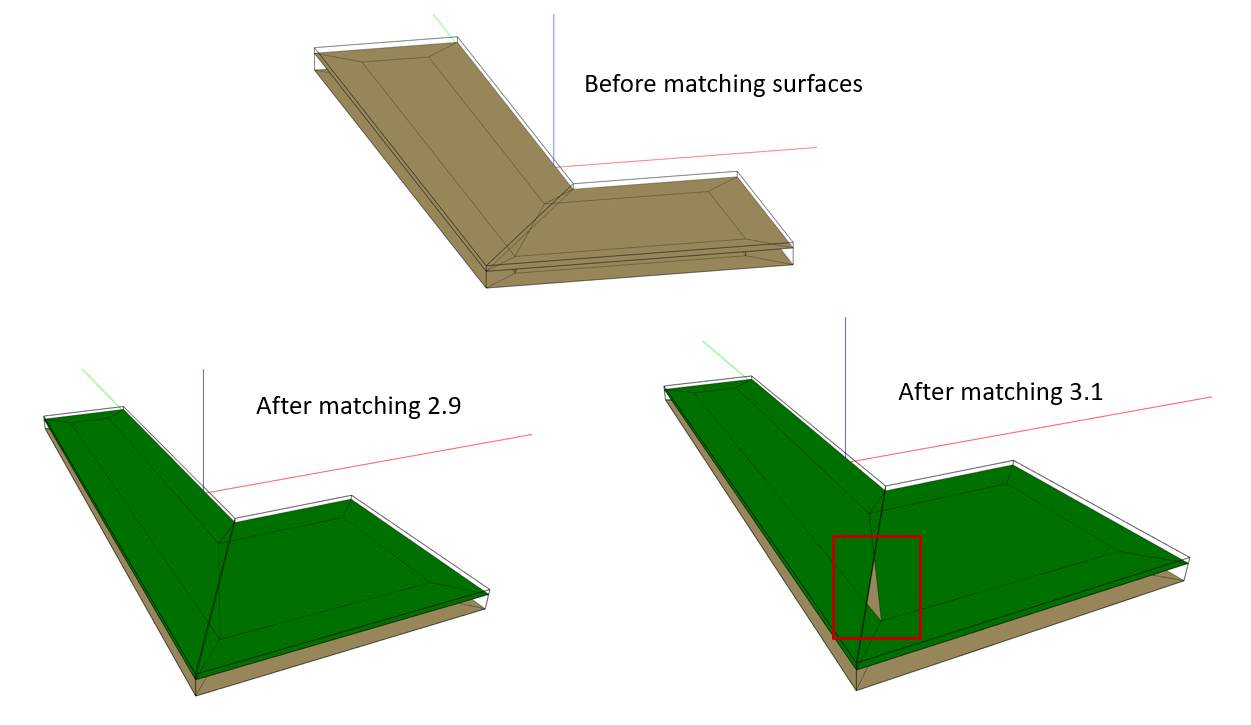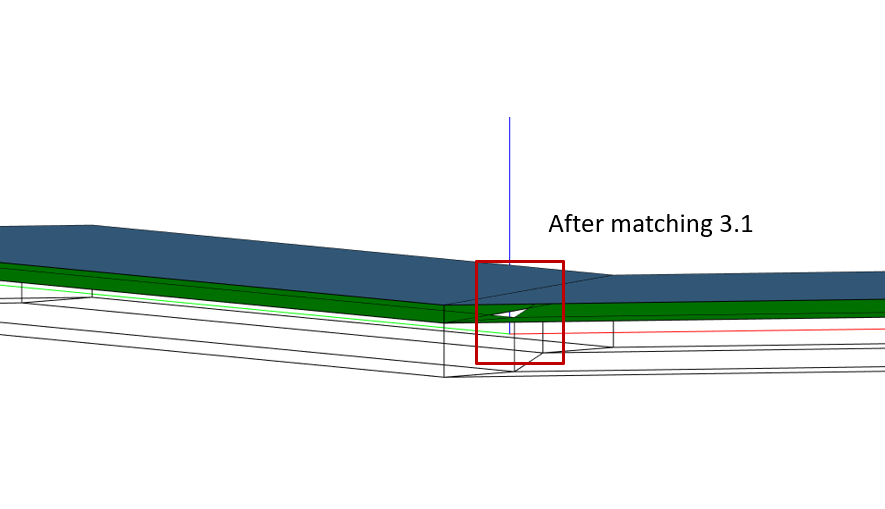When doing regression checks on updating to OpenStudio 3.1 from 2.9 I noticed big shifts in energy. Upon inspection, I found that L shaped buildings had surface matching issues that were not present in our OS 2.9 models. This happens upon the intersection of a plenum space with a perimeter and core section of the building.
See the image below to show what I mean. At the top, you'll see the model before surface matching. Below, you'll see the model in OS 2.9 and in 3.1. You'll notice how the boundary condition for the floors changes to Surface for all the surfaces except a sliver that remains adjacent to Ground.

If you look at the roof surfaces, you'll notice this sliver is now missing altogether in OS 2.9.

I'm unsure why this is happening. Here is a clue I get when doing the surface matching in OS 3.1
[openstudio.model.Surface] <1> Initial area of surface 'Surface 18' 646.605 does not equal post intersection area 646.605
Things I have checked:
- The order in which spaces are matched is identical
- Both versions of OpenStudio agree upon which spaces intersect.
- The OpenStudio methods
OpenStudio::Model.intersectSurfaces(spaces)andOpenStudio::Model.matchSurfaces(spaces)do not resolve the issue (they made it worse somehow, not sure why).
LINK TO MINIMUM WORKING EXAMPLE:
Meat of the surface code is under match_spaces on L95
https://github.com/jugonzal07/stack_overflow_questions/blob/master/unmet_hours/surface_matching_os_2.9_to_3.1/surface_matching_script.rb
require 'openstudio'
# Helper to load a model in one line
def osload(path)
translator = OpenStudio::OSVersion::VersionTranslator.new
ospath = OpenStudio::Path.new(path)
model = translator.loadModel(ospath)
if model.empty?
raise "Path '#{path}' is not a valid path to an OpenStudio Model"
else
model = model.get
end
return model
end
# Class created for the sole purpose of making spaces comparable.
# Sorting is dependent on space bounding box boundaries
class SpaceSort
attr_accessor :space, :min_x, :max_x, :min_y, :max_y, :min_z, :max_z
def initialize(os_space)
bounding_box = os_space.boundingBox
@space = os_space
@min_x = bounding_box.minX.to_f
@max_x = bounding_box.maxX.to_f
@min_y = bounding_box.minY.to_f
@max_y = bounding_box.maxY.to_f
@min_z = bounding_box.minZ.to_f
@max_z = bounding_box.maxZ.to_f
end
# Sorting for SpaceSort objects follows this hierarchy (from lowest to highest)
# -min_x, max_x, min_y, max_y, min_z, max_z
# NOTE: -1 = less than
# 1 = greater than
# 0 = equal to
def <=>(other_space_sort)
if @min_x < other_space_sort.min_x
return -1
elsif @min_x > other_space_sort.min_x
return 1
elsif @max_x < other_space_sort.max_x
return -1
elsif @max_x > other_space_sort.max_x
return 1
elsif @min_y < other_space_sort.min_y
return -1
elsif @min_y > other_space_sort.min_y
return 1
elsif @max_y < other_space_sort.max_y
return -1
elsif @max_y > other_space_sort.max_y
return 1
elsif @min_z < other_space_sort.min_z
return -1
elsif @min_z > other_space_sort.min_z
return 1
elsif @max_z < other_space_sort.max_z
return -1
elsif @max_z > other_space_sort.max_z
return 1
else
return 0 #bounding boxes are identical
end
end
end
def sort_spaces(spaces)
# Array of SpaceSort objects, used to sort spaces by their bounding boxes
space_sort_list = []
# Construct SurfaceSort objects for sorting surfaces
spaces.each do |space|
space_sort_list << SpaceSort.new(space)
end
# sort SurfaceSort objects by their bounding box boundaries
sorted_list = space_sort_list.sort()
sorted_spaces = []
# Extract spaces from sorted SurfaceSort objects
sorted_list.each do |space_sort|
sorted_spaces << space_sort.space
end
return(sorted_spaces)
end
def match_spaces(spaces)
# Sort spaces for consistency between models
spaces = sort_spaces(spaces)
n = spaces.size
boundingBoxes = []
(0...n).each do |i|
boundingBoxes[i] = spaces[i].transformation * spaces[i].boundingBox
end
(0...n).each do |i|
(i+1...n).each do |j|
next unless boundingBoxes[i].intersects(boundingBoxes[j])
puts "#{spaces[i].name.to_s} intersects #{spaces[j].name.to_s}"
spaces[i].intersectSurfaces(spaces[j])
spaces[i].matchSurfaces(spaces[j])
end #j
end #i
end
file_name = 'before_matching_3.1.osm'
model = osload(file_name)
match_spaces(model.getSpaces)
# spaces = OpenStudio::Model::SpaceVector.new
# model.getSpaces.each do |space|
# spaces << space
# end
#OpenStudio::Model.intersectSurfaces(spaces)
#OpenStudio::Model.matchSurfaces(spaces)



